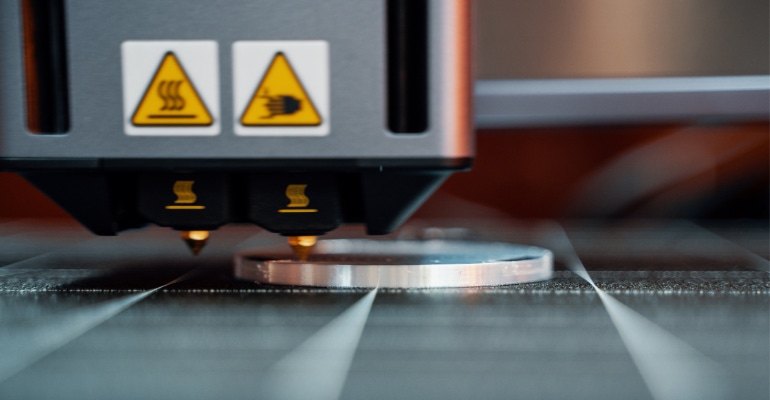Does Reshoring Enable Higher Utilization of 3D Printing?
With a recent report showing 67% of medtech manufacturers are likely to reshore back to the US, additive manufacturing could come as a cost-saving goldmine.

There are multiple factors shaping medical device manufacturing. And this has been especially true over the last 3 years with a pandemic, war, economic uncertainty, and disrupted supply chains all creating cracks in the manufacturing ecosystem. While the industry has already seen its shakeups to address these challenges, 2023 seems to be the year in which many companies are implementing strategic changes to start patching the cracks in an effort to move toward more sustainable, and reliable, operation.
These strategies are creating trends in how many manufacturers currently operate. In Xometry’s 2023 Medical Device Manufacturing Report, two main changes noted were the uptick in additive manufacturing and reshoring.
Additive manufacturing, which the benchmark study tied with injection molding, automation technologies, and packaging services, became increasingly used during the COVID-19 pandemic and has continued as an alternative to remain competitive on the world stage. However, many companies, according to the study, are increasingly deciding to implement these changes domestically, reshoring global operations back to United States soil (67%).
“The majority of medical device manufacturers are likely to add North American suppliers to their supply chain within the next year, with 12% of respondents indicating that they are ‘extremely likely’ to do so,” the report wrote.
This includes companies seeking packaging materials, and sourcing automation technologies domestically.
There are a number of factors playing a role in the phenomenon, spokesperson for Xometry told MD+DI, including, “raw material shortages, increasing raw material prices, finding reliable suppliers, customer risk assessments, staying on top of US and ROW regulations, remaining competitive, lead time, quality, shortage of labor, raising funds, using AI, finding vendors that want to deal with a small manufacturer, supply chain transparency, supply chain issues, qualified human resources, digitization, finding reliable manufacturers, and global uncertainty like inflation, the war in Ukraine, and COVID-19 making it difficult to plan.”
For the companies seeking to reshore in the next 12-months, a relatively short timeframe, the report cited the, “Increasing tensions as military spending ramps up amid Russia’s invasion of Ukraine, continuing supply chain disruptions in China, and global raw materials shortages threaten the security of our nation’s medical device reserve. Medical industry experts cite lead time, quality, and supply chain transparency as chief concerns in their industry."
The vast majority of these reshoring efforts, they said, will occur in the US — upwards of 75% — compared to locations in South America, like Mexico. And cost of labor in the US may be one of the reasons additive manufacturing is becoming the go-to alternative, with the Xometry spokesperson giving a simple, “Yes,” when asked.
B9Creations, an additive manufacturing company, agreed when interviewed by MD+DI, with a spokesperson noting, “Yes, as the trend toward reshoring continues to gain traction, the implementation of additive manufacturing will likely surge, as well. Onshoring manufacturing, supply chain resiliency, and just-in-time production for products in critical industries, like healthcare, will continue to grow in importance — as will the role additive manufacturing plays in the solution. 3D-printing is positioned to play a pivotal role in enabling localized production, customization of complex medical devices, and in the manufacturing process from rapid prototyping to short-run production, spare parts, and manufacturing aids.”
3D-printing can be used in many steps during the manufacturing process, including R&D, design and prototyping, tooling and jig production, customized and small-batch production, and mass customization with both benefits and potential drawbacks, according to B9C.
For R&D, benefits include the quick and cost-effective testing and refinement of concepts before moving to mass production as 3D-printing speeds up the design iteration process and reduces the time to market. However, “3D-printing materials used for prototyping and design validation may not exactly replicate the properties of final production materials, which can lead to variations between prototypes and end products,” the spokesperson said.
The benefits of using 3D-printing for customized and small-batch production include the way it “excels in producing individualized and small-batch items — ideal for creating personalized products, medical implants, and more on-demand,” they said, adding, “a drawback of using 3D-printing is that the per-unit cost can be relatively high compared to traditional mass manufacturing methods in high-volume part runs.”
Now that 3D-printing is no longer confined to prototyping or small-scale production and is “increasingly employed for end-use and serial production,” according to B9C, “… it’s anticipated that this technology will operate with equal capability and credibility and stand as a viable alternative to traditional and precision production methods.”
With advancements in biocompatible materials and regulatory approvals further accelerating the integration of 3D-printing, it seems many medical device manufacturers are keen to jump on the additive manufacturing train.
“This shift reflects a trend toward more personalized and efficient healthcare solutions,” a spokesperson for B9C said.
About the Author(s)
You May Also Like



.png?width=300&auto=webp&quality=80&disable=upscale)
